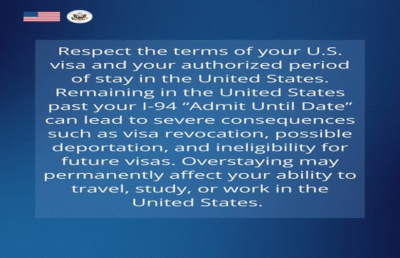In recent months, the United States has taken an increasingly tough stance toward India, not only through the imposition of steep tariffs—raising duties on many Indian exports to unprecedented levels—but also through strict enforcement of immigration rules. The US Embassy in India has issued stern warnings to visa holders, emphasising that overstaying even by a single day can result in serious consequences such as visa revocation and ineligibility for future travel or work. Together, these actions underscore how the US is ramping up harsh measures both economically and diplomatically, making it clear that any breach—whether in trade or visa compliance—will be met with severe penalties. Recently, on the 4th of August, the US Embassy posted a tweet on X which says:

What is I-94?
I-94 is a crucial and official document provided by U.S Customs and Border Protection (CBP) for nonimmigrant visitors to the USA for arrival and departure records, which proves you have been lawfully admitted to the US. So, I-94.
How to apply for or see your current Form I-94?
Customs and Border Protection (CBP) typically issues Form I-94 electronically.
- If you are traveling by air or sea, a Customs and Border Protection officer will issue you an electronic I-94 at your point of entry during the admission process.
- If you are travelling by land, you can apply for an I-94 in person at your point of entry. Or you can apply it within 7 days before entering the U.S. through the official I-94 website or the CBP One app. When you do so, you will pay a $6 fee. This is a provisional I-94. It does not guarantee entry into the U.S.
With the CBP One app or I-94 website, you can also:
- See your most recent I-94 form and print it, in case you need your record of legal admission to the U.S. The CBP One app also allows you to have a digital version of your I-94 on your phone.
- Get a travel history from the last 10 years of your arrivals and departures from the U.S.
- Find out how long you are legally allowed to stay in the US.
Customs and Border Protection (CBP) sends visitors email reminders about their remaining time in the U.S. In addition, it sends notifications to travelers who may have exceeded their admission period. Departing the U.S. with Form I-94 In most cases, your departure from the U.S. will be recorded electronically, whether you are traveling by air, land, or sea.
Who needs an I-94 form?
Everyone entering the U.S. needs an I-94 form except:
- American citizens
- Returning resident aliens
- Non-U.S. citizens with immigrant visas
- Most Canadian citizens who are visiting or in transit
I-94 records consist of essential information which includes: –
- Your admission number: – Every I-94 record has an eleven-digit admission number. This number may be needed at the Department of Motor Vehicles and for employment purposes, but it is not a number that needs to be memorized. In fact, a new I-94 number will be given each time the student or scholar re-enters the United States.
- Your class of admission (e.g. B-2 for tourist, F-1 or M-1 visa for student).
- Length of the time “admit until date” this is the most important piece of information which
I-94 states. Basically, it is the time period that tell the authorized period of stay in united states. Individual must depart the U.S on or before this date.
- Fixed date: for most of the nonimmigration visitors there will be a specific date (e.g., 08/11/2025).
- “D/S” (Duration of Status): On the passport admission stamp or the paper
I-94 card, the inspector writes either a date or “D/S” (duration of status). Students and scholars on F or J status should receive a stamp marked “D/S” or “duration of status.” This means that they may remain in the United States as long as they are properly maintaining status and their I-20 (F-1) or DS-2019 (J-1) has not expired. Students and scholars are required to keep the passport entry stamp or I-94 card for the duration of their visit. Make sure to keep it in a safe place so it doesn’t get lost.

What are the major consequences of overstaying?
Overstaying your I-94 “Admit Until Date” is a serious violation of U.S. immigration law and can have severe, long-term consequences Depending on how long you overstayed a US visa, you might be banned from reentering the US. the major consequences of overstaying will be
- Visa Revocation: Your current U.S. visa will automatically be voided even if it is multiple entry visa, you cannot use it to enter the US again.
- Deportation: You could be placed in removal proceedings and deported from the country.
- Future Ineligibility: You may become ineligible for future visas or other immigration benefits.
- Re-entry Bans: Depending on how long you overstay, you could face a 3-year, 10-year, or even a permanent ban on re-entering the U.S.
- 3-year ban: Overstaying for more than 180 days but less than a year.
- 10-year ban: Overstaying for more than one year.
- The Visa Integrity Fee Explained
According to the 2025 budget reconciliation law added what’s called a “Visa Integrity Fee. The new Visa Integrity Fee is a $250 charge that you pay when you get a nonimmigrant visa. You can get this money back, but only if you follow all the rules of your visa. This means you must leave the U.S. on or before your visa expires.
Conclusion
In summary, the I-94 form is a vital document that defines your legal stay in the United States, and strict adherence to its “Admit Until Date” is crucial. Overstaying not only risks immediate penalties such as visa revocation and deportation but can also lead to long-term bans from re-entry, severely impacting your future opportunities in the U.S. With the added Visa Integrity Fee incentivizing compliance, it is more important than ever to respect U.S. immigration rules. In the current climate of heightened U.S. scrutiny—both economically through tariffs and diplomatically through strict visa enforcement—maintaining lawful status is essential for preserving your ability to travel, study, and work in America without disruption.



Leave a Reply